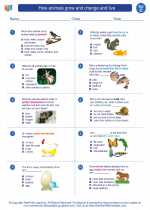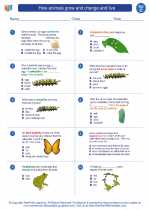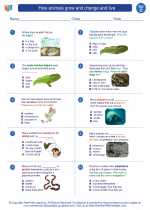How Animals Grow and Change
Animals go through different stages of growth and change throughout their lives. These stages include birth, growth, maturity, and, in some cases, reproduction. Let's explore each of these stages in more detail:
Birth
Most animals are born from their parents in various forms such as eggs, live birth, or larvae. Some animals, like mammals, are born live and are dependent on their parents for care and nourishment. Others, like insects, hatch from eggs and undergo metamorphosis before reaching adulthood.
Growth
After birth, animals grow and develop. This can involve physical changes in size, shape, and bodily functions. Animals need food, water, and a suitable environment to support their growth. They may go through different growth stages, such as infancy, childhood, and adolescence, before reaching maturity.
Maturity
Once animals reach maturity, they are fully developed and capable of reproduction. This stage varies across different species. Some animals reach maturity within a few months, while others take several years. Maturity marks the peak of an animal's physical and reproductive capabilities.
Reproduction
Reproduction is the process of producing offspring. This ensures the continuation of the species. Animals employ various methods of reproduction, such as laying eggs, giving birth to live young, or producing offspring through asexual reproduction. Reproduction is vital for the survival of animal populations.
How Animals Live
Animals interact with their environment and other organisms in various ways to meet their needs for food, shelter, and survival. Let's explore how animals live and adapt to their surroundings:
Habitat
Each animal species has its own specific habitat where it can find food, water, shelter, and other necessities for survival. Some animals are adapted to live in water, while others thrive in forests, deserts, grasslands, or polar regions. Understanding an animal's habitat is crucial for its survival.
Feeding and Nutrition
Animals have diverse feeding habits and diets. Some are herbivores, feeding on plants, while others are carnivores, preying on other animals. Some animals are omnivores, consuming both plants and animals. Each species has specific nutritional needs to maintain health and energy.
Survival Adaptations
Animals have evolved various adaptations to survive in their environments. These adaptations may include camouflage, protective coloration, physical features, and behaviors that help them avoid predators or capture prey. Adaptations are essential for an animal's survival in the wild.
Social Behavior
Many animals exhibit social behaviors by living and interacting with others of their species. This can include forming groups, establishing hierarchies, and cooperating for activities like hunting, raising offspring, or defending territory. Social behavior is important for communication and survival.
Conclusion
Understanding how animals grow, change, and live provides insights into the diversity and complexity of the animal kingdom. By studying these processes, we can appreciate the remarkable adaptations and behaviors that enable animals to thrive in their environments.
.◂Science Worksheets and Study Guides Third Grade. How animals grow and change and live

 Study Guide
Study Guide
 Worksheet/Answer key
Worksheet/Answer key
 Worksheet/Answer key
Worksheet/Answer key
 Worksheet/Answer key
Worksheet/Answer key
 Worksheet/Answer key
Worksheet/Answer key
 Vocabulary/Answer key
Vocabulary/Answer key
 Vocabulary/Answer key
Vocabulary/Answer key
